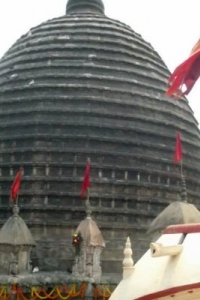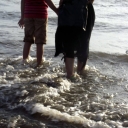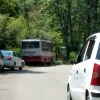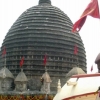
We had come upon a destination called Bhimar Charia while we were searching for locales in Hajo. After we had visited the Hayagriba Madhab Temple, we decided to check this attraction.
Our driver either didn’t have any clue about this location or he thought that this was a place of no importance to any tourist who was coming to Hajo, he showed complete ignorance about this place. We checked about the same from the person who was selling the material for worshipping (poojan samigri) at the temple. Thankfully she was willing to help and tried to give us directions to the place. We realised that this place was quite close to the temple.
The Bhimar Charia (Bheem’s Bowl (katora)/Bucket) is around a kilometre away from Hayagriba Madhab temple close to the Gokarana hills. The place was again peaceful, tucked away in midst of fields and forests, a few meters ahead of the point from where one needs to climb for Kedar Temple.
There was a dilapidated board by Assam Tourism standing right outside the gates of Bhimar Charia. Two ladies were selling knick-knacks close to the gateway (no, they were not there because it was a tourist destination, but because there were few houses in the vicinity). Parking the vehicle was easy – just parked it on the opposite side in the open ground. We climbed a few stairs (around 10) and reached a platform where there was a large stone basin. This stone basin is huge. The platform is now in an open enclosure which has a roof held by brick pillars. The whole area is enclosed with a simple boundary wall. Just next to the boundary wall we could see houses where local inhabitants were residing.
This place finds mention in many ancient religious and historical texts. Some texts mention it as ‘Bhimar Paintakhowa Charia’, the basin in which the second Pandava Bheem ate rice. It is said that this was the place where the Pandavas had spent some time during their exile (just before the Agyaatwaas – the time they went into hiding).
Another legend (probably this was popularised by the British army personnel) says that this is the basin which Bheem used for having a bath. (Doesn’t seem pretty logical, why would anyone try to have luxuries of a bath basin/bath tub when they were in exile and living a life of hardship?)
Some Hindu legends say that this is the basin in which Lord Shiva brewed his potion of hemp/bhaang. (This place is quite close to Kedar temple and thus this could be the reason of this legend).
The Buddhist also laid claim to this stone basin. Wendell in his studies (with references from Tibetan and Bhutanese Buddhist texts) mentions that the Buddhists believe that this is the pot where Death Demons boiled the heads of the Damned; this is the place where snakes lived.
Going by the size of the basin, I don’t think this legend has any logic to it. Yes there might be snakes living here (just as they live in any other place surrounded by bamboo trees and rice fields), but we didn’t see a single of them.
We could not see any one – neither people following Hinduism nor Buddhism who could throw more light on the origin of the legend. This place needs to be visited not for the legends but for the architectural marvel. Whatever legend one wants to believe is left to one’s own judgement.
Location : Hajo, District Kamrup, Assam. It’s around 30 kilometres from Guwahati
How to reach – Taxis/Tourist Cabs are easily available from Guwahati which would take one to Hajo.
It’s advisable to use the services of authorised guides to understand the locale better. Anyone can visit this location. This destination would not take more than 10-15 minutes (maximum, that too if one wants to enjoy the calmness) and can be easily clubbed with visit to Kedar temple or Ganesh temple.
About the Author




Comments